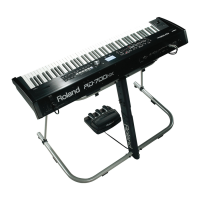51
Making Detailed Settings for the ONE TOUCH Tones
E. Piano Parameters
Parameter Value Description
Tone
TINE EP
This is an E. Piano that widely used in the ‘70s. It is a standard sound that was loved by jazz and fusion
players, and continues to have numerous fans to this day.
This sound is characterized by a bell-like attack and a mild tone, and is indispensable in today’s styles,
such as smooth jazz and acid jazz.
TINE EP2
This is a new type of E. Piano. It is a variation of the Tine EP.
FM TINE
TINE EP3
TINE EP4
REED EP
This is an E. Piano that made its appearance in the ‘60s and was widely used in rock and R&B. It has a
distinctive dynamism, with gentle pianissimo sounds and strongly played notes that are reminiscent of
resonance sounds on a synthesizer.
This E. Piano continues to be used by numerous musicians today.
REED BELL This is a new type of E. Piano, combining the characteristics of a Tine EP and a Reed EP.
REED EP2
This is a new type of E. Piano. It is a variation of the Reed EP.REED EP3
REED EP4
SA EP1 This is the E. Piano 1 sound of the Roland RD-1000, which was released in 1986.
SA EP2 This is the E. Piano 2 sound of the RD-1000.
* Depending on
the tone you select, some of the parameters described below may not produce any change in the sound
when you edit them.
Bar Angle -10–0–+10
The typical E. Piano produces sound when a hammer strikes a metal rod called the tine with tone bar,
whose vibrations are detected by a pickup. On this type of piano, the tonal character can be adjusted by
changing the angle of the tone bars and pickups.
Higher settings will emphasize the fundamental, producing a thicker sound.
Pickup Distance -2–0–+2
The typical E. Piano uses pickups to convert the vibrations of the tone bars into sound. By adjusting this
parameter, you can obtain the eect of changing the distance between the tone bars and the pickups.
Lowering this value will move the tone bars and pickups farther apart. This makes it easier for you to
produce varied dynamics. Increasing this value will produce a more powerful sound.
Bell/Thump -10–0–+10
This adjusts the balance between two components of the attack; the Bell component and the Thump
produced by the hammer.
Adjusting this value from 0 toward the negative side will emphasize the bell sound, while adjusting it
toward the positive side will emphasize the hammer sound.
Bell Character -10–0–+10
This adjusts the tonal character of the bell sound included in the attack.
Adjusting this value from 0 toward the negative side will produce a heavier character, while adjusting it
toward the positive side will produce a lighter character.
Damper Noise -10–0–+10
This adjusts the damper noise (the noise heard when you press the damper pedal to release the tone
bars).
Increasing this value will make the damper noise louder.
* Depending on the selected Tone, this may have no eect.
Key O Reso (Key O
Resonance)
-10–0–+10
This adjusts resonances such as the key-o sound (the faint sound heard when you release a key).
Higher values will produce a louder key-o sound.
At a setting of -10 there will be no key-o sound at all.
* Depending on the selected Tone, this may have no eect.
HUM Noise -10–0–+10
This adjusts the amount of hum and other noise that leaks into the pickups.
Electric pianos were susceptible to various types of noise, and this noise would sometimes be output
along with the sounds of the performance. Depending on the eect settings, such noises can produce
an authentic, lively atmosphere.
Adjusting this value from 0 toward the negative side will produce a clearer sound, while adjusting it
toward the positive side will produce a dirty sound.
At a setting of -10 there will be no hum at all.
* Depending on the selected Tone, this may have no eect.
Tuning Type TYPE 1, TYPE 2
By changing the tuning type you can change the way in which chords will resonate.
* Depending on the selected Tone, this may have no eect.
Level 0–127 This adjusts the volume of the E. Piano tone.

